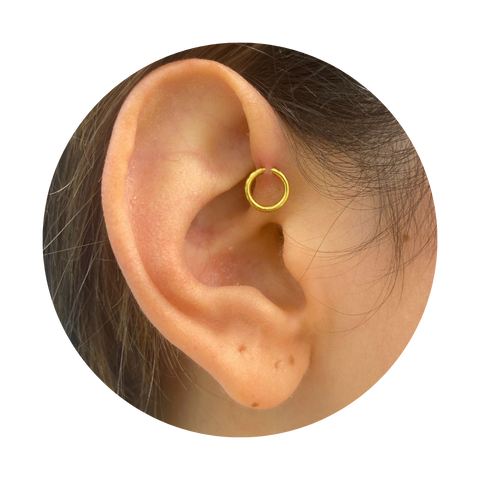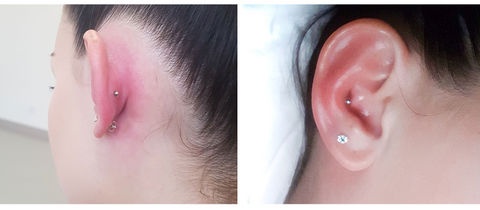Ah, the joys of getting pierced! Between keloids , rejection , and infections , it's safe to say the world of piercing sometimes has its share of surprises. But don't worry, we're here to guide you and avoid those complications worthy of a bad movie script.
So get ready, because we're going to explain how to recognize, treat, and most importantly, how to play superhero to avoid these problems and promote optimal healing . Put on your cape and your coolest jewelry, let's go
1. Keloid
How to recognize a keloid? 
- A bump at the piercing
- Sensitivity in the area
- A pink or red coloration around the bump
- Do not handle your piercing outside of care
- Avoid jewelry that is too tight, too large, or inappropriate for your piercing.
- Follow carefully post-piercing care recommended by your piercer
So you've inherited a keloid that's decided to take over your piercing? Don't panic, we have a special article titled " How do I get rid of my keloid ?" where we share our tips for taming this unwanted guest. Secret recipes, mystical incantations, and maybe even a tribal dance might be included.
2. Rejection
Rejection! Your body plays the fussy nightclub bouncer who thinks your piercing jewelry is an unwanted intruder. It takes its job very seriously and decides to push the jewelry toward the skin's surface, for expulsion. It seems your body is an expert at removal; the process usually occurs when the jewelry is placed too superficially or if there's an allergic reaction to the jewelry's materials.
How to recognize a piercing that is rejecting?
- The jewelry moves away from the initial piercing
- The skin around the piercing is thin or damaged

- Choose good quality jewelry made from safe materials like titanium or surgical steel
- Avoid sudden movements, tension or friction on your piercing
- Monitor your piercing carefully and consult a professional if in doubt.
3. Infection
Infection is an inflammatory reaction in the body caused by bacteria, viruses, or fungi that turn your piercing into a fabulous playground. Don't let an infection spread and play havoc with your body, get rid of it quickly!
In case of infection, Take the necessary measures and show him who's boss! Consult your doctor, who may prescribe antibiotics, often in the form of a cream to be applied directly to your infected piercing.
If you want to know all the "don't do this!, don't do that!" points of healing, our article Contraindications for good healing is the guide to mistakes to avoid!
How to recognize an infection in your piercing?
- Redness, warmth and excessive swelling of the pierced area
- Presence of pus (yellowish liquid) coming out of the piercing (Be careful! We are not talking about lymph , which is a transparent liquid)
- Severe pain, tenderness, or itching

How to avoid infections?
- Wash your hands before touching your piercing
- Clean your piercing regularly with a recommended sterile saline solution
- Be careful with anything that comes into contact with your pierced ear (headphones, hair, pillowcase, pets, etc.)
- Do not handle your jewelry during the healing period
- Avoid swimming, hammocks and saunas for the first two months following piercing.
- Avoid anti-inflammatory medications in the days following the piercing.
Now that you are an expert in keloids , rejection and infection, you will know how to take the appropriate measures in each case (for example, you will not intensively disinfect a keloid at the risk of seeing it grow).
Healing your piercing is a bit like watching a captivating soap opera with twists and turns at every turn. If you want to be the perfect spectator of this incredible saga, don't miss our article " Healing Your Piercing Step by Step ."
So take care of your piercing, listen to your body, and don't hesitate to seek professional help if necessary. Keep your style and your health in perfect balance!

